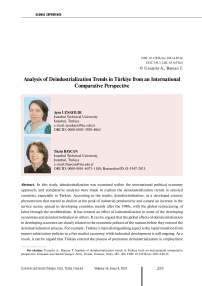Analysis of deindustrialization trends in Turkiye from an international comparative perspective
Автор: Uzsayilir A., Baycan T.
Журнал: Economic and Social Changes: Facts, Trends, Forecast @volnc-esc-en
Рубрика: Global experience
Статья в выпуске: 4 т.16, 2023 года.
Бесплатный доступ
In this study, deindustrialization was examined within the international political economy approach, and comparative analyzes were made to explain the deindustrialization trends in selected countries, especially in Turkiye. According to the results, deindustrialization, as a developed country phenomenon that started to decline at the peak of industrial productivity and caused an increase in the service sector, spread to developing countries mainly after the 1990s, with the global restructuring of labor through the neoliberalizm. It has created an effect of industrialization in some of the developing economies and deindustrialization in others. It can be argued that the global effects of deindustrialization in developing countries are closely related to the economic policies of the nations before they entered the deindustrialization process. For example, Turkiye’s main distinguishing aspect is the rapid transition from import substitution policies to a free market economy, while industrial development is still ongoing. As a result, it can be argued that Turkiye entered the process of premature deindustrialization in employment in terms of a direct transition from agriculture to the service sector and the inability of the service sector to absorb the labor force emerging from agriculture and industry, but this is a non-structural phase that can be overcome with alternative socioeconomic and spatial planning.
Deindustrialization, globalization, political economy, comparative analyzes
Короткий адрес: https://sciup.org/147241622
IDR: 147241622 | УДК: 330.3 | DOI: 10.15838/esc.2023.4.88.16
Текст научной статьи Analysis of deindustrialization trends in Turkiye from an international comparative perspective
The aim of the study is to analyze the regional character of deindustrialization and to reveal international political economy causality, different forms of deindustrialization in the global context and deindustrialization trends in Turkiye. The study emerged from a scientific curiosity about the dynamics behind the phenomenon of deindustrialization, which we observe concretely in the urban area and which can often be understood as an urban transformation activity. What are the political economic conditions of deindustrialization, which is mostly measured in a particular unit, region or sector? It is expected that a holistic study including theoretical and empirical research, will form a ground on which measures can be developed against deindustrialization. For this purpose, a literature review was carried out in the second part, and the conceptual framework formed. In the third section, a comparative analysis of employment and, accordingly, the changes in GDP and unemployment indicators in selected countries is made, and the results are given in the fourth section.
The study is expected to contribute to the literature and, to upper-scale socioeconomic and spatial planning especially in developing countries, and to form a basis for alternative development models.
Deindustrialization is not only a phenomenon that expresses the transformation of labor force from industry to services in certain units, but means the global restructuring of the labor across regions. In this restructuring, this study reveals the advantageous and disadvantageous aspects of the regions, and defines the main disadvantage as facing free market economy and international competition while the industrialization process of the countries continues. The original comparison study carried out in the study confirms this definition. The contribution of the study at the empirical level is to create an international sample, analyze it on employment and income indicators, classify the countries and explain the results with political economy causality by establishing a relationship with the literature.
In the study, social and regional science disciplines were used and deindustrialization was investigated with theoretical and empirical analysis. A combined qualitative and quantitative research methodology was employed. Qualitative data-based methods (theoretical analyses) include literature research, analytical approach, analysis of the information and data. Quantitative methods (empirical analysis) include creating an international sample and comparing, classifying and visualizing data on sectoral employment and income.
In the literature, some studies examine the issue of deindustrialization through various indicators and scales. To begin with though, a holistic study is required to understand the historical and international political economic conditions of deindustrialization and to explain the specific aspects of Turkiye compared to other countries.
When deindustrialization is defined within the framework of the classical view that sees this process as a positive process related to productivity, it turns into an inevitable phenomenon. This view reflects the modernization approach, which is based on the premise that all societies will follow the same-linear development line and inequalities will be balanced later. Against this approach, critical theory has revealed capitalist development is dependent on the relation between the center-periphery and defined the possibilities of independent economic development.
There are continuities covering long historical periods under the changes of the historical process (Braudel, 2017 [1949]). The core-periphery theory of the Dependency School’s studies (Prebisch, 1950; Amin, 2018 [1988], Amin, 1991; Frank, 2010 [1998]), which was the main scientific development in the 1960s is overlooked in the face of technological developments and diversity in today’s radically globalized world. In the face of the complexity of work and labor, scientific paradigms tend to diverge from basic structural dynamics and context at the phenomenological level. In this context, the main concern of the study is to explain deindustrialization in the context of center-periphery relationality, which is a historical continuity, and to create an alternative basis for development.
As the study underlines and argues, deindustrialization is not an usual development process but a politically regulated global economic transformation. This process has meant abandoning their dynamic advantages for most developing countries. On the other hand, it is debatable that deindustrialization mean a development and the next advanced business organization also for developed-Western economies (Ryazanov, 2018).
In this study, the industrial sector is considered as a dynamic sector, as in (Kaldor, 1966) approach among early studies. Among the studies after the 1980s, Krugman’s (Krugman, 1991) views that he opened the center-periphery relationality to the discussion by questioning “why industrial development concentrated in a few regions and left others relatively behind”; §enses’s views on “the interruption of industrial development in Turkiye” (§enses, 2004); and Ryazanov’s views (Ryazanov, 2018) that defines as “post-industrial nihilism” the delusion that the increasingly complex structure of modern industrial society will replace industrial production with the service sector, were accepted.
Empirically, the studies (Lorenzi, Berrebi, 2016) and (Ryazanov, 2018) which research industrial development in developed and developing countries, are taken as a reference. Additionally, the works (Dasgupta, Singh, 2006) and (Rodrik, 2016) on
“premature deindustrialization” in developing countries, (Bakir et al., 2019) on the trends in Turkiye and the study (Dogruel, Dogruel, 2019) evaluating the changes in economic policies after 1990 are taken into account.
The results of international comparisons, in line with the literature, reveal the relationship of deindustrialization with the global restructuring of production and labor. In addition, as a periodical solution produced through new regionalism and the transformation of cities, it also gives clues to domestic capital mobility. For this reason, the arguments put forward in (Baycan-Levent, 2005), (Keyder, 2014), (Dogruel, Dogruel, 2018) on the transformation of the industry from the center to the periphery within the framework of the global city vision for Istanbul have been discussed as the subject of the following study.
Conceptual framework
The definitions of deindustrialization are based on early studies that reflect neoclassical economic thought and explain deindustrialization as a usual development process. According to the three sectors or Clark-Ficher model, which is based on the arguments of Clark and Fischer (Clark, 1940; Fischer, 1939), structural change and development in the economy are explained by expansion from the primary sector (agriculture) to the secondary (industry) and tertiary (services) sectors. In this context, with its most basic definition; deindustrialization means a severe decrease in the industrial sector workforce and, in turn, a rapid increase in the service sector workforce.
The authors of the 1960s also examined deindustrialization within the scope of economic growth. In comparison, some authors shared the pioneering views of the 1940s and described it as a usual process (Rostow, 1959; Kuznets, 1973). On the other hand, even though industrial production was the main factor in economic development and the growth in the service sector, there have been opinions that the decrease in production will slow down economic development (Kaldor, 1966).
In the rapid globalization phase after the 1980s, with the appear the negative consequences of deindustrialization in developed countries and the spread of the deindustrialization of developing countries, the scope of studies in the literature has changed. Therefore, the relationship of deindustrialization with international trade and capital mobility, its regional character, and positive and negative aspects have begun to be emphasized (Bluestone, 1984; Krugman, 1988, Krugman, 1991; Rowthorn, Ramaswamy, 1997; Kollmeyer, 2009a; Kollmeyer, 2009b; Lorenzi, Berrebi, 2016; Alderson, 1999; Rowthorn, Wells, 1987; Dasgupta, Singh, 2006; Rodrik, 2016; Ryazanov, 2018; Kornev, 2022).
In Turkiye, significant studies in the field of political economy have focused on the neoliberal economic policies behind deindustrialization, its internationally differentiated form, and its impact on the economy (Kepenek, 1999; §enses, 2004; Yeldan, 2006, Yeldan, 2011; Kolsuz, Yeldan, 2014; Yeldan, Yildirim, 2015; Dogruel, Dogruel, 2019).
Studies on deindustrialization trends focused on sectoral and periodic changes according to economic indicators. While some of these studies claimed that premature deindustrialization started in Turkiye (Bakir et al., 2019; Kose, Dineri, 2020), some other studies argued that there is a tendency to deindustrialization but that premature deindustrialization cannot be mentioned (§iklar, Tonus, 2007; Oz, 2018; Yanikkaya et al., 2019).
Studies investigating deindustrialization trends at the regional level have focused on the changing characteristics of deindustrialization according to regions and periods (Dogruel, Dogruel, 2018; Megik, Aytun, 2018). In spatial studies at the theoretical level, the transformation of cities and deindustrialization are considered as parallel processes (Keyder, 2014). Studies examining deindustrialization in specific units have focused on the mobility of industrial facilities on an urban scale (Yuceba§, 2014; Kur^uncu, 2016; Ayik, 2018; Ayik, Avci, 2018).
As a result of the literature research, the primary references for this study are outlined below.
According to the results of Kaldor’s analysis by comparing the slowdown in the economic growth rate in England with other developed countries, there is a positive relationship between the growth rate in industrial production and the growth rate of national products. With this, there is a positive relationship between growth in production and productivity in manufacturing and other sectors. For this reason, Kaldor defined the industrial sector as the locomotive of economic growth. Kaldor argues that England has the problem of “premature maturity” compared to other developed economies and that the industrial sector has reached the highest level. Therefore economic growth has slowed down (Kaldor, 1966). Kaldor classically explained deindustrialization with the productivity in industrial production, but he argued that unlike Clark and his followers, the industrial sector continues to be a dynamic sector.
Among the post-1980 studies, Krugman, who won the Nobel Prize in economic sciences for his work on commercial models and the locality of economic activity, offers a new perspective on the causes of concentration (agglomeration) of industrial activity based on neoclassical economics and mainly the work (Marshall, 1890). Krugman reopened the center-periphery relationship by arguing that the development in some regions left others behind (Krugman, 1991).
§enses, responsible for one of the main studies in Turkiye, underlines that the most acute effects of neoliberal globalization in underdeveloped countries are the gradual weakening of the understanding of the welfare state and the falling of industrialization from the agenda. §enses argues that the forms of deindustrialization differ between the core and peripheral countries. The deindustrialization of developing countries and developed economies are a specious analogy. In addition, he draws attention to the unique situation in which industrialized East Asian countries develop with government regulations instead of free markets (§enses, 2004).
In their studies on international deindustrialization trends, Lorenzi and Berrebi have drawn attention to the effects of the offshoring mechanism from developed to developing countries and revealed that in the second globalization period, after the 1990s, industrial activity shifted to certain regions in a much more specific way than in the 1970s. According to the results, the industrial value added of the country has rapidly shifted between developed and developing countries in connection with the world industrial value added. A sharp change in world industrial value was added between 1995 and 2005. According to Lorenzi and Berrebi, the change in industrial activity in the 1990s is exceptional. All Western countries have been affected by international activity transfer in terms of developing countries. The whole world has been affected, including the countries where the transfer of activity has never occurred, although China is centered (Lorenzi, Berrebi, 2016).
The form and effects of deindustrialization differ in developed and developing economies. In this context, the main explanation defining deindustrialization in developing countries is the “premature deindustrialization” thesis.
Dasgupta and Singh conducted a Kaldorian analysis of premature deindustrialization and identified several long-term structural trends in developing countries. According to this, in some developing countries, deindustrialization started at a deficient level of per capita income compared to developed countries. In addition, both slow (e.g., Latin America) and fast-growth economies (e.g., India) are experiencing the phenomenon of “jobless growth” in the formal manufacturing sector, that is, growth that does not create jobs. According to their findings, Dasgupta and Singh argue that, as an exceptional example, the service sector in the Indian economy can develop into a dynamic industry in economic growth, especially in information and communication technologies (ICT) and related fields. In other developing countries, industrial production continues to be the dominant sector in development, so deindustrialization is a negative situation in these countries (Dasgupta, Singh, 2006).
Another researcher on premature deindustrialization, Rodrik, defines deindustrialization in developing countries as “premature”. It is unlike historical norms, occurs before industrial production and income reach a sufficient, high level. While industrialization has positive effects, such as producing technology and absorbing the workforce, premature deindustrialization adversely affects economic growth. According to Rodrik, while increasing productivity is effective for industrialization-deindustrialization patterns of developed economies, the effect of globalization is more pronounced in developing countries. According to two important conclusions suggested by Rodrik; 1) there is a significant displacement of manufacturing from the richer countries of the world (mainly the USA and Europe) to Asia, especially China; 2) the share of production in the gross domestic product has changed differently in various regions. Moreover, according to Rodrik, despite the positive characteristics of deindustrialization in developed economies, these countries (e.g., America) develop policies to protect themselves from the decline in the industrial sector. On the other hand, the deterioration in industrial policies and deindustrialization with all its negative features continue in underdeveloped (e.g., SubSaharan Africa) and developing (e.g., Latin America) countries (Rodrik, 2016).
Among the studies on deindustrialization trends in Turkiye, Bakir et al., in their study covering the 1998—2014 period, argues that Turkiye has entered the process of deindustrialization and that the contraction in the textile and clothing sectors is the main sectoral factor. The research draws attention to both the triggering and accelerating effects of domestic value added decreases, which occur with Turkiye’s rapid integration into global value added chains, on deindustrialization. In this process, the dependence of production and exports on imports is increasing rapidly. This dependency also affects the decrease in domestic value added rates, requiring effective measures. Bakir et al. draw attention to the fact that, in this case, deindustrialization for Turkiye, besides being “premature”, may deepen. Deindustrialization in Turkiye is explained by its rapid and early participation in the international “new” division of labor (Bakir et al., 2019).
Concerning periodic changes, Dogruel and Dogruel have included post-1990 economic policies and post-2008 paradigm shift in their studies. Accordingly, while deindustrialization expressed structural changes due to internal factors in developed countries before, the effect of globalization started to come to the fore (in the diffusion) after the 1990s. The financial crisis that occurred at the advanced stage of this has led to a paradigm shift in the economic policies of the countries after 2008 towards protectionism in foreign trade and has made deindustrialization an uncertain process for both developed and developing countries today (Dogruel, Dogruel, 2019).
In this study, which examines industrial transformation at the international level, the literature and analysis results also give clues to the dynamics of this process at the country level. It can be argued that deindustrialization, which occurs at the national and international levels, and the emergence of global cities, regional clusters, and city-regions are parallel processes.
For example, in the case of Istanbul, Baycan-Levent emphasized that while competing with other global cities, metropolises create the conditions in which the global economy can function, and in this process, they redefine the development conditions and processes of the peripheral regions (Baycan-Levent, 2005). Similarly, Keyder draws attention to the relationship between global cities and deindustrialization and emphasizes that using the concept of global city-region may require going beyond provincial borders. Keyder shows as an example that “when Istanbul entered the deindustrialization process in the 1980s, the manufacturing was not only moved within the borders of the province, but also went to Qorlu, Gebze, Izmit and even Bursa (to regions outside the provincial borders)” (Keyder, 2014).
In this context, according to Dogruel and Dogruel, who drew attention to deindustrialization and periodically differentiated industrial policies in Istanbul, policies focused on the decentralization of industry from the urban area before 2000 and then on growth in the finance and real estate sectors in the city (Dogruel, Dogruel, 2018).
Another topic in the literature is reindustrialization. Krugman (Krugman, 1988; Krugman, 1991) emphasizes capital mobility in reindustrialization and the change of technology in this process, technology-intensive new business branches that rise instead of old industries. However, he states that the new industries and the service sector are not at a sufficient level to absorb the workforce that has emerged with deindustrialization. Kornev (Kornev, 2022), in the case of Russia, argues the view that new industries should be supported by state subsidies in the face of deindustrialization that emerged with the transition to open economy after the Soviet era.
Ryazanov primarily criticizes the view that the industry will be replaced by the service sector. Reminding the historical conditions, he argues that the service sector will not replace the industry, just as industry has not replaced agriculture but developed it. According to Ryazanov, deindustrialization is a negative situation not only for non-Western economies but also for Western capitalist economies. Because, after the decrease in the textile and clothing sector in the beginning, employment in technology production started to decrease gradually in the advanced stages of deindustrialization. Ryazanov argues that dynamic potentials should be mobilized for reindustrialization. Specialization and technology development will depend on the development of the industrial sector for all countries and their involvement with new industries in the international division of labor (Ryazanov, 2018).
As the literature research shows, deindustrialization is closely related to globalization, international capital mobility, and the global restructuring of labor in this process. The deindustrialization process and its dynamics differ between international regions. While deindustrialization is a process related to productivity in developed countries, the effect of globalization comes to the fore in developing countries. The international transfer of industrial activity, one of the central dynamics of deindustrialization, causes deindustrialization in developed countries. This process leads to industrialization in some developing countries and deindustrialization in others (with a specious similarity to developed countries). Therefore, deindustrialization is a process that needs to be examined regionally at the international level and shows different trends according to the regions.
International comparative analysis of deindustrialization trends in T u rkiye
According to the information obtained from the literature research, it can be seen that deindustrialization is a phase in modern industrial production, its relationship with capital mobility, and international trade. In this process, production and labor are restructured internationally and at the country level regionally. In this context, a comparative analysis of sectoral changes was made in selected countries to determine international deindustrialization trends.
Regarding the studies (Lorenzi, Berrebi, 2016; Ryazanov, 2018; Dogruel, Dogruel, 2019), the analysis is based on the post-1990 period when radical changes began to be seen in developing countries. The timeframe is limited to prepandemic 2019. First of all, employment and, accordingly, changes in GDP and unemployment data were examined.
In the comparison study, countries were selected regarding the studies (Lorenzi, Berrebi, 2016) and (Ryazanov, 2018), Turkiye and some others included in the Asia-Pacific Economic Cooperation were added. Accordingly, the 18 countries within the scope of the research are as follows: 7 countries in the developed countries category: United States, Japan, France, Germany, United Kingdom, Canada, Italy, and 11 countries in the developing countries: China, India, Brazil, South Korea, Mexico, Indonesia, Australia, Turkiye, Hong Kong, Singapore and Russia.
Sectoral employment
According to the changes in sectoral employment between 1991 and 2019 in the selected countries ( Fig. 1 ), the agricultural sector’s shares decreased in all countries, and the shares of the service sector increased. The employment share of
Figure 1. Changes in sectoral employment shares between 1991–2019
|
agriculture |
industry 1991-2019 |
services 1991-2019 |
||||||
|
199 |
-2019 |
|||||||
|
-34.37 |
China |
9.94 |
India |
China |
||||
|
28.35 |
||||||||
|
-27.01 |
Indonesia |
7.17 |
Indonesia |
Hong Kong |
24.45 |
|||
|
India |
||||||||
|
-20.72 |
6.02 |
China |
South Korea |
21.71 |
||||
|
-16.99 |
World |
0.81 |
World |
Russia |
21.58 |
|||
|
-11.65 |
Türkiye |
0.08 |
Mexico |
Singapore |
19.85 |
|||
|
-10.56 |
Brazil |
-3.43 |
Brazil |
Indonesia |
19.83 |
|||
|
-9.47 |
South Korea |
-4.34 |
Türkiye |
World |
16.17 |
|||
|
-8.61 |
Mexico |
-4.45 |
Australia |
Türkiye |
15.99 |
|||
|
-8.41 |
Russia |
-4.63 |
Canada |
Brazil |
14.00 |
|||
|
-4.42 |
Italy |
-6.05 |
USA |
Japan |
13.72 |
|||
|
-3.50 |
■ |
France |
-7.96 |
France |
Italy |
13.51 |
||
|
-3.35 |
■ |
Japan |
-9.09 |
Italy |
UK |
13.41 |
||
|
-2.80 |
■ |
Australia |
-10.37 |
Japan |
Germany |
12.82 |
||
|
-2.27 |
■ |
Germany |
-10.54 |
Germany |
France |
11.45 |
||
|
-1.98 |
■ |
Canada |
-12.24 |
South Korea |
India |
10.78 |
||
|
-1.11 |
UK |
-12.30 |
UK |
Mexico |
8.53 |
|||
|
-0.64 |
Hong Kong |
-13.17 |
Russia |
Australia |
7.24 |
|||
|
-0.57 |
USA |
-19.61 |
Singapore |
USA |
6.63 |
|||
|
-0.25 |
Singapore |
-23.81 |
Hong Kong |
Canada |
6.61 |
|||
Own elaboration according to: ILO ; World Bank ; 2023 data.
the industrial sector varies according to the regions. This situation is remarkable in terms of showing the regional character of deindustrialization. Another issue that needs to be emphasized is that although the share of employment in the agricultural sector is decreasing in all countries, the most affected are the countries that had an agricultural society at the start of deindustrialization and still continued the industrialization process.
In the category of developed countries, there has been no radical change since the 1990s. During this period, industrial employment in these countries gradually declined from the 35–25% band to the 25–20% band. The agricultural sector is low and the industrial workforce is absorbed mainly by the service sector. As a developed country phenomenon, it can be said that deindustrialization is a structural transformation depending on capitalist economic policies and international activity transfer in these countries.
According to the analyzes within the scope of this study, Three types of trends can be mentioned in developing countries. (1) China, Indonesia and India, which are in the first category, are the main parties of international trade and the transfer of activities from the West to the East, and their industrialization processes are increasingly continuing. (2) Countries in the second category, consisting of South Korea, Russia, Hong Kong, Singapore and Australia, show a tendency towards deindustrialization. While these countries, with a specious analogy to developed countries in terms of global impact rather than internal-structural factors, were showing a certain industrial development they entered the stage of deindustrialization; agriculture is declining less than industry and there is a sectoral transition from industry to services. (3) Third, in the group consisting of Turkiye, Brazil and Mexico, there is a serious decrease in the agricultural sector and a slight decrease, which can be called a stagnation, in the employment of the industrial sector. While these countries were agricultural societies and their industrialization processes continued, they faced deindustrialization. Therefore, the service sector has to directly absorb the workforce released from agriculture. Again, in these countries, with a specious analogy with developed countries, there is no radical decrease in industrial employment. The reason for this is that they entered the process of deindustrialization as a global impact while their industrial development was at a low level.
The countries where the substantial change from the West to the East occurred are the Asian countries that industrialized in this process. In India, Indonesia, and China, three developing countries where deindustrialization in the world has an industrialization effect, this effect is seen mainly in the 2000–2012 period ( Tab. 1 ).
Among these countries, China is a remarkable example. In 2012, the share of industry and service employment in China approached each other in the 30% band. After this date, industrial employment began to lose momentum, and service employment began to increase rapidly. The reasons for this in China can be seen as the decreasing foreign demand since 2012, the increase in workers’ wages in the domestic market, and the slowdown in economic growth due to inflation. It is an important factor that high industrial added value leads to expansion in the service sector by increasing specialization investments. It can be argued that its historical and
Table 1. Group 1 countries industrial employment share, %
|
Year |
India |
Indonesia |
China |
||||||
|
A |
I |
S |
A |
I |
S |
A |
I |
S |
|
|
1991 |
63.32 |
15.18 |
21.50 |
55.51 |
15.19 |
29.31 |
59.70 |
21.40 |
18.90 |
|
2000 |
59.65 |
16.32 |
24.04 |
45.28 |
17.44 |
37.29 |
50.01 |
22.50 |
27.49 |
|
2012 |
47.00 |
24.36 |
28.64 |
35.93 |
21.07 |
43.00 |
33.60 |
30.30 |
36.10 |
|
2019 |
42.60 |
25.12 |
32.28 |
28.50 |
22.36 |
49.14 |
25.33 |
27.42 |
47.25 |
Note: A – agriculture, I – industry, S – service sector.
Own elaboration according to: ILO ; World Bank ; 2023 data.
Table 2. Group 2 countries industrial employment share, %
|
Year |
South Korea |
Russia |
Hong Kong |
Singapore |
Australia |
||||||||||
|
A |
I |
S |
A |
I |
S |
A |
I |
S |
A |
I |
S |
A |
I |
S |
|
|
1991 |
14.61 |
36.82 |
48.57 |
14.24 |
39.96 |
45.80 |
0.81 |
34.89 |
64.30 |
0.28 |
35.16 |
64.56 |
5.36 |
23.51 |
71.14 |
|
2000 |
10.60 |
28.15 |
61.25 |
14.49 |
29.24 |
56.27 |
0.29 |
20.33 |
79.38 |
0.16 |
27.95 |
71.89 |
4.86 |
21.62 |
73.53 |
|
2012 |
6.13 |
24.58 |
69.29 |
7.33 |
27.81 |
64.86 |
0.21 |
12.36 |
87.43 |
0.10 |
20.54 |
79.36 |
2.80 |
20.71 |
76.49 |
|
2019 |
5.14 |
24.58 |
70.28 |
5.83 |
26.79 |
67.38 |
0.17 |
11.08 |
88.75 |
0.03 |
15.55 |
84.41 |
2.56 |
19.06 |
78.38 |
Note: A – agriculture, I – industry, S – service sector.
Own elaboration according to: ILO ; World Bank ; 2023 data.
political character is the most important factor that differentiates China from other countries in its category during this transformation phase.
The second category includes South Korea, Russia, Hong Kong, Singapore and Australia, which have been deindustrialized. In these countries, overall, there has been a sharp decline in industrial employment. When these countries begin to deindustrialize, their industries are generally developed and agricultural employment is low. Therefore, sectoral transition is transforming from industry to services. In this category, Industrial employment shares decreased significantly especially in 1990–2000 ( Tab. 2 ).
The island countries Hong Kong and Singapore, which rapidly industrialized in the 1960s and called “Asian Tigers”, and another island country Australia, started to rise as the global financial and transportation centers of the Asia-Pacific since the 1990s. These countries have historical and political similar characteristics. The industrializationdeindustrialization processes in these regions, which have long been in intense relations with Western-developed economies, took place in this direction.
After the Second World War, South Korea rapidly industrialized through the export-led growth model. The change of management in 1987 and the
1997 Asian Crisis led South Korea increasingly from planned development to short-term programs.
Russia is a special example in this category. Industrial development in the country, which differs from its category with its historical and political character. After the disintegration of the Soviet regime in 1991, Russia, which tried free market-oriented and centralized development models, stabilized after the great financial crisis in 1998 and became the leading country in raw material exports after the 2000s. At this stage, China-Russia cooperation (Zuenko, 2020) has gained more importance than ever before. The cooperation they developed as a result of the historical and political characters of the two countries, their border neighborhood, supply-demand relationship in raw materials and manufactured products has been the main dynamic of the non-Western pole in their geography.
In the third category, there are countries with a gradual decline in industrial production, but with a large employment loss in agriculture. The agricultural workforce is mostly absorbed by the service sector. There are no significant changes between 1991 and 2019 in these countries, where agriculture and industry gradually decreased and the service sector increased (Tab. 3).
Table 3. Group 3 countries industrial employment share, %
|
Year |
T u rkiye |
Brazil |
Mexico |
||||||
|
A |
I |
S |
A |
I |
S |
A |
I |
S |
|
|
1991 |
29.76 |
29.66 |
40.58 |
19.64 |
23.42 |
56.94 |
21.09 |
25.47 |
53.44 |
|
2000 |
27.30 |
27.62 |
45.08 |
16.49 |
21.84 |
61.68 |
17.41 |
27.07 |
55.53 |
|
2012 |
23.56 |
26.03 |
50.42 |
11.47 |
23.02 |
65.51 |
13.72 |
24.06 |
62.22 |
|
2019 |
18.11 |
25.32 |
56.57 |
9.08 |
19.99 |
70.94 |
12.48 |
25.55 |
61.97 |
Note: A – agriculture, I – industry, S – service sector.
Own elaboration according to: ILO ; World Bank ; 2023 data.
The relatively low decline in industrial employment in these countries is similar to the slow decline in Western-developed economies, but this is a specious similarity. Countries in this category have entered the stage of deindustrialization while not yet sufficiently industrialized. The common features of these countries are being an agricultural society that has not yet completed its industrial development and providing industrial development with import substitution policies before deindustrialization; rapid transition to a free market economy and implementation of the programs of international monetary institutions in this process. In these countries, there has been a decline in industry and a relative increase in the service sector since 1990, while the agricultural sector has regressed radically. The result of this is, firstly, the problem of direct transition from agriculture to services, and secondly, the lack of sufficient increase due to the fact that the development in the service sector depends on the productivity in industry (the gap between the labor force released from agriculture and that absorbed by the service sector, that is, the increase in unemployment).
Regarding the global changes in employment, it is seen that there has been a severe transfer of labor and specialization from the developed countries of the North to the developing economies in Asia since the 1990s. It can be argued that countries such as Turkiye and Latin America countries, which are outside of this two-polar development, are deindustrialized as an effect of the process of global restructuring of the labor.
In this group, Turkiye differs historically and politically from other countries in its group. Turkiye had development experience with import substitution economic policies before deindustrialization. While it was still in the industrialization stage, with a series of regulations known as the January 24 decisions, it made a rapid and sudden transition to the free market economy in 1980, and industrial production began to decline in the face of international competition.
As a result, the period 1991–2019 can be mentioned as radical deindustrialization phase. In this phase industrialization-deindustrialization interaction can be mentioned in the first and second group countries, while in the third category, there is stagnation in industrial development rather than deindustrialization. Therefore, there is no single form of deindustrialization; deindustrialization shows different cause and effect relationships regionally, takes different forms, takes place within the scope of development plans and can therefore transform. It can be argued that factors such as the historical conditions of the countries and the economic policies they implemented before deindustrialization were influential in the forms of deindustrialization.
Based on the literature, the analysis period of the study was determined as 2019 after 1990, when radical changes were seen, and before the pandemic ( Fig. 2–7 ).
Figure 2. Agriculture employment shares in developed countries
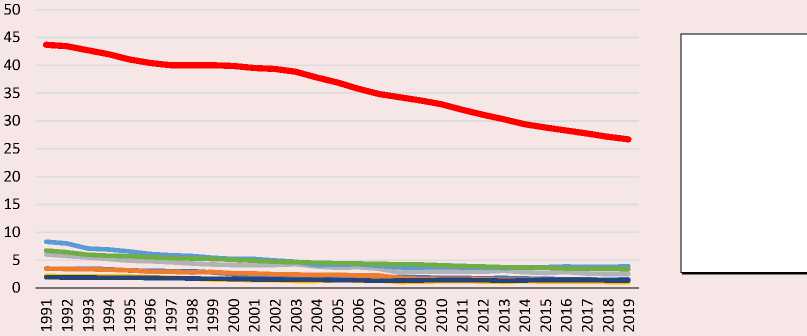
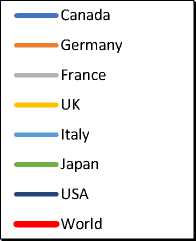
Own elaboration according to: ILO ; World Bank ; 2023 data.
Figure 3. Agriculture employment shares in developing countries
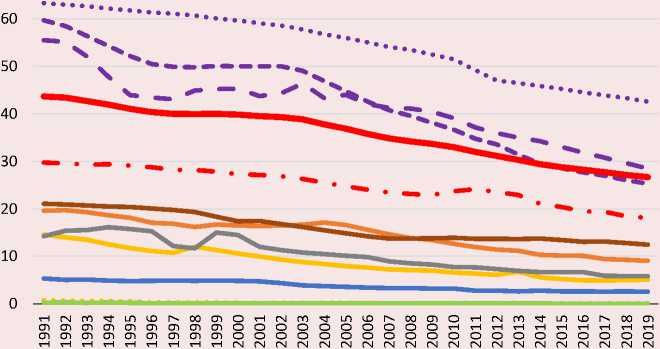
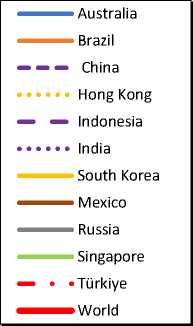
Own elaboration according to: ILO ; World Bank ; 2023 data.


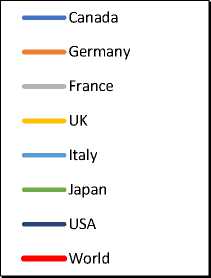

Figure 6. Service employment shares in developed countries
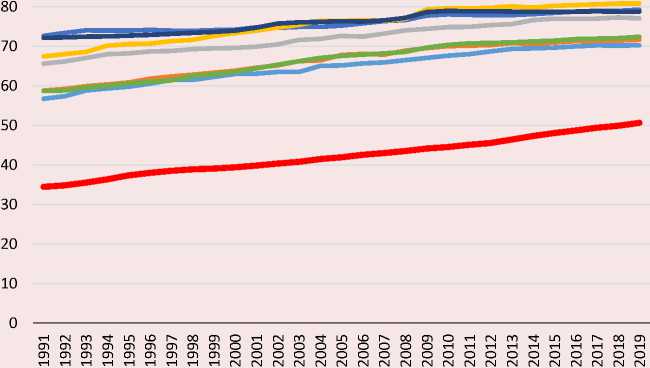
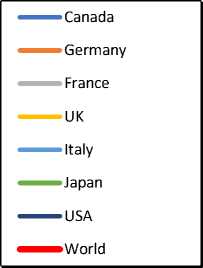
Own elaboration according to: ILO ; World Bank ; 2023 data.
Figure 7. Service employment shares in developing countries
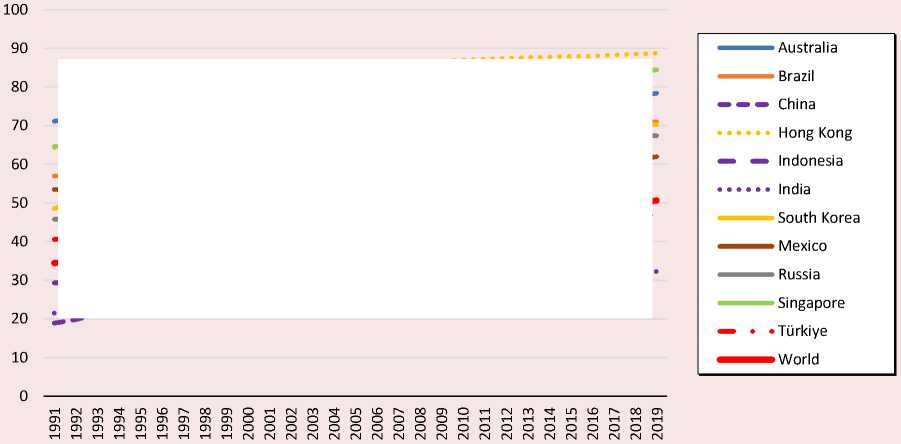
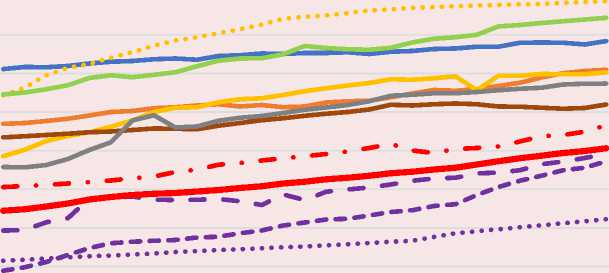
Own elaboration according to: ILO ; World Bank ; 2023 data.
GDP
In order to strengthen sectoral employment comparisons, which is the main indicator of the study, GDP and unemployment indicators were also compared. According to the analysis in this study, the shares in the world’s total GDP have changed between developed and developing economies since 2010 ( Fig. 8 ). This result is in line with (Lorenzi, Berrebi, 2016) that the radical change in employment occurred between 1995 and 2005. Continuing the changes in Industrial Employment, the shares of total GDP also shifted. It is interesting that the industry income started to change in the 90s and shifted in 2010. The transfer of activity to the economies of China, Indonesia and India and the rapid industrialization of these countries are effective in this result in the category of developing countries. This result is compatible with the view of Lorenzi and Berrebi in Kaldorian analysis that industry is still a dynamic sector in developing countries.
According to the sectoral changes, it is observed that the transition between sectors in the GDP shares of developed countries occurred until the 1990s. In comparison, there were significant changes in developing countries after the 1990s (Fig. 9–14).
In all developed and deindustrialized countries, the share of agriculture GDP is below the world average, while the share of services GDP is average and above. While Germany showed stability in the world average in industrial GDP, the industrial income in Japan and Canada, which remained above the average until the 2010s, started to decline in these years. It can be said that Japan is avoiding a decrease in its industrial income while it continues to fall in Canada. In other developed economies where industrial income was below the world average, it continued to decline steadily: USA, England, Italy, and France.
In developing countries, the share of agricultural GDP in total income fell sharply between 1991 and 2000 in industrializing nations and continued to decline. While declining steadily in China, agricultural income in India and Indonesia slowed down after the 2000s. In these countries, after 2008,
Figure 8. World GDP shares

Developed countries Developing countries
Own elaboration according to: World Bank ; OECD ; 2023 data.
there was a stagnation in industry income and an increase in the service sector. However, among the selected countries, these are the countries with the highest share of industry GDP above the world average and the lowest share of services GDP.
While Russia had the highest share of industrial income among non-Western deindustrialized countries, with 45.86% in 1991, this ratio decreased sharply in the period after the disintegration of Soviet Russia and fell to 34.53% in 1995. The second sharp decline in Russia occurred in the late 90s and early 2000s during the period known as the Russian economic crisis or the Ruble crisis. Brazil caught a growth trend in its industrial income between 1991–1994 and experienced a severe decrease between 1994–1995. The share of industry income was 35.42% in 1994, was 23.38% in 1995. Industry income, which remained relatively stable at 20% until 2014, showed a decreasing trend after this date. While the share of service sector revenue in Brazil reached its highest level at 73.33% in 1993, it fell abruptly to 56.89% in 1994. After Brazil opened its economy to the
world markets in 1989, it faced hyperinflation. Although it got rid of this bottleneck for a while with its local monetary policies, it could not maintain these policies due to the Asian crisis and the Ruble crisis in Russia and started to implement the IMF program in 1999.
Turkiye’s industry has reached the highest share in GDP since 1960, with 32.97% in 1989. The industry income, around 30% in 1986–1998, decreased to 28.28% in 1999 and stabilized in the 28–26% band since 2000. It can be argued that Turkiye’s implementation of the IMF program in 1999 and development policies based on the transformation of industry in the urban area are non-structural protections implemented against crises. A more dramatic reduction than the share of industrial income occurred in the agricultural sector. While the percentage of agricultural GDP in the total was 54.91% in 1960, it decreased to 26.14% between 1960 and 1980. Another significant decrease was observed in the 1996– 2000 period, with agricultural GDP falling from 16.85% to 10.03%, reaching 6.4% in 2019 ( Fig. 15 ).
Figure 9. Turkiye GDP sectoral shares
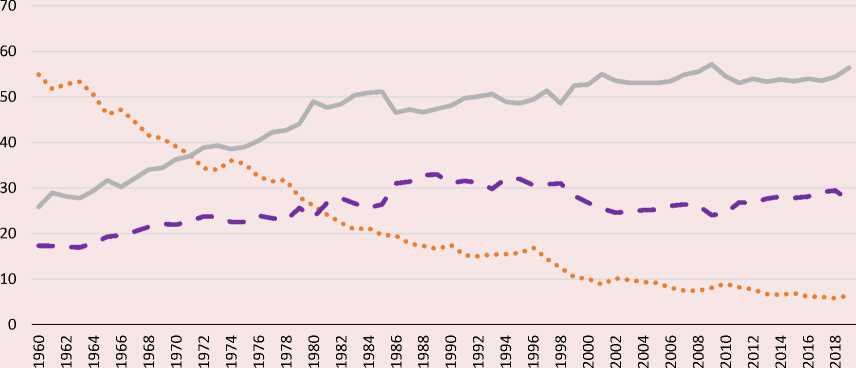
Agriculture Industry Services
Own elaboration according to: TURKSTAT ; World Bank ; OECD ; 2023 data.
-
Figure 10. Developed countries’ agriculture GDP shares
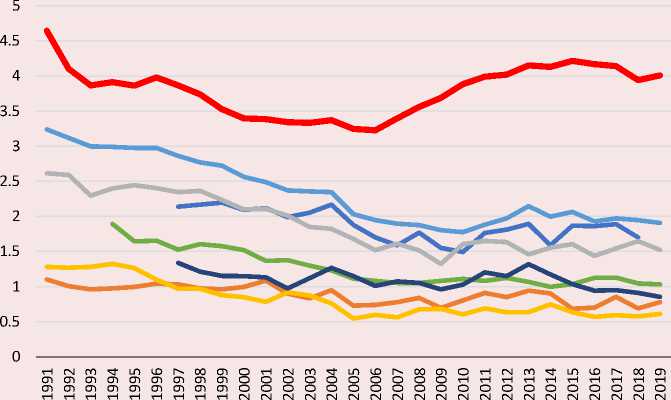
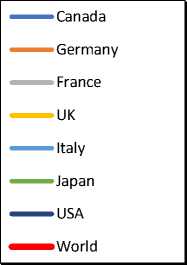
Own elaboration according to: World Bank ( https://data.worldbank.org/ ); OECD ( https://data.oecd.org/gdp/gross-domestic-product-gdp.htm ); 2023 data.
-
Figure 11. Developing countries’ agriculture GDP shares
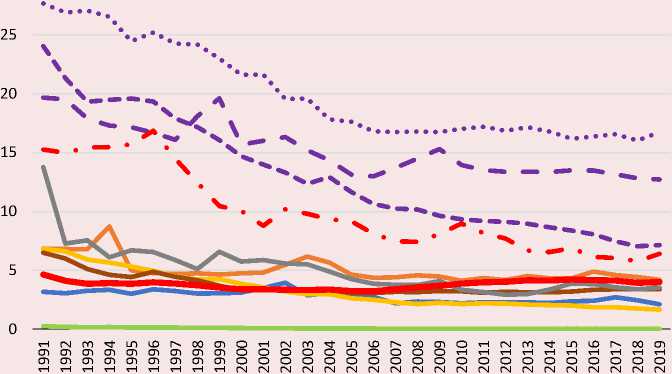
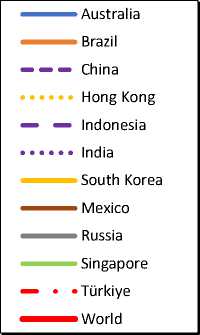
Own elaboration according to: World Bank ( https://data.worldbank.org/ ); OECD ( https://data.oecd.org/gdp/gross-domestic-product-gdp.htm ); 2023 data.
-
Figure 12. Developed countries’ industry GDP shares
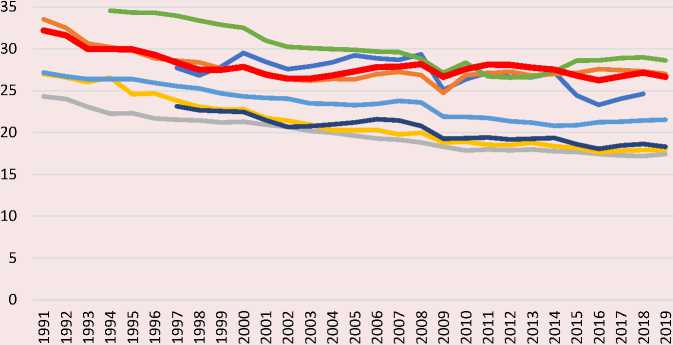
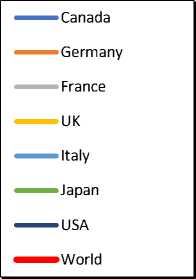
Own elaboration according to: World Bank ( https://data.worldbank.org/ ); OECD ( https://data.oecd.org/gdp/gross-domestic-product-gdp.htm ); 2023 data.
-
Figure 13. Developing countries’ industry GDP shares

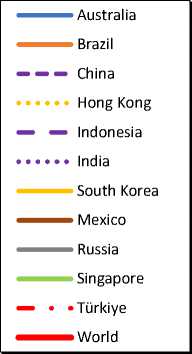
Own elaboration according to: World Bank ( https://data.worldbank.org/ ); OECD ( https://data.oecd.org/gdp/gross-domestic-product-gdp.htm ); 2023 data.
Figure 14. Developed countries’ service GDP shares
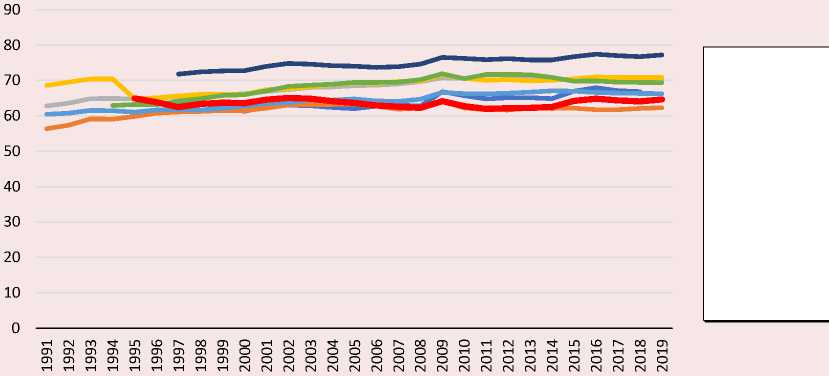
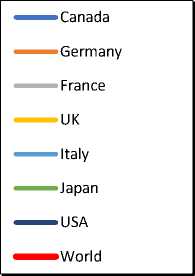
Own elaboration according to: World Bank ; OECD ; 2023 data.
Figure 15. Developing countries’ service GDP shares

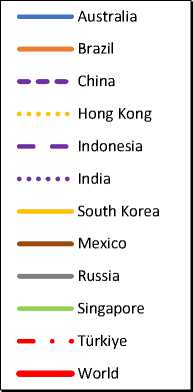
Own elaboration according to: World Bank ; OECD ; 2023 data.
Therefore, deindustrialization in employment can be mentioned in Turkiye, but this situation can be expressed as stagnation in terms of industrial incomes. The factor causing the negative results is the radical decline in the agricultural sector and the shift of the workforce emerging from agriculture to the services sector.
Unemployment
According to the selected countries’ unemployment rates, Turkiye’s unemployment increased by 6 points from 7.7% to 13.7% in the 1991-2019 period (See Figure 16). According to the general trends in the world, it is seen that unemployment rates increased from 1991 to 1999 and stabilized after the 2000s. As an exception to this, unemployment rates in Turkiye started to grow from this date ( Fig. 17, 18 ).
It can be argued that deindustrialization in Turkiye is premature and unfavorable in terms of the significant decrease in agricultural employment, the decline in industrial employment despite this, the stagnation in industrial income and the direct transition from agriculture to services. This has had not only economic but also serious social and
urban consequences. It can be argued that the conditions for this were formed in the 1960s, during the industrialization period. Two major waves of migration from village to city took place in Turkiye in the 1960s and 1990s. Although the 1960s was already a period of industrialization, industrial production could not provide sufficient employment for the population that had to migrate to the cities by breaking the fence in the countryside. While only a part of the migrating population is employed in the factories, the majority of them are scattered in the service sector jobs, small production, tradesmen or informal sector, which are diversified in the production geography. While the service sector share was 25.84% in 1960, it reached 50% in the early 1980s and was 56.40% by 2019. By the 1980s, the service sector was already approaching the 2019 rate. Therefore, in the post-2000 deindustrialization period, there has not been a service expansion to the extent that the labor force emerging from agriculture and industry can be absorbed. Therefore, unemployment after 2000 has become higher and more chronic than unemployment in the 1960s and 1980s.
Figure 16. Unemployment rates change in selected countries 1991 and 2019
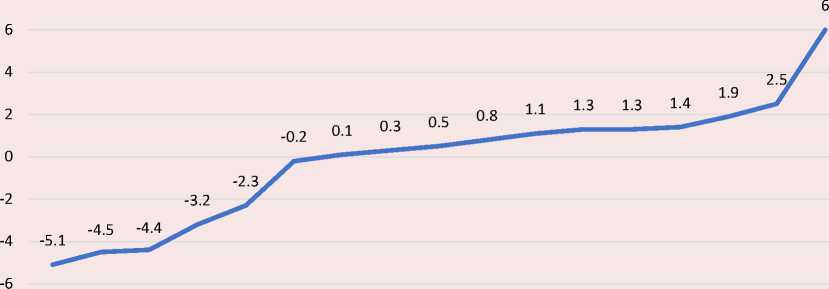

Own elaboration according to: ILO ; IMF ; 2023 data.
Figure 17. Unemployment rates periodical changes




1991 1999 2019
Own elaboration according to: ILO ; IMF ; 2023 data.
Figure 18. T G rkiye unemployment rates


Own elaboration according to: TURKSTAT ; ILO ; IMF ; 2023 data.
Conclusion
According to international comparisons, it can be argued that deindustrialization shows different trends depending on the political economy and geopolitical-geoeconomic conditions of the countries. In this study, deindustrialization trends, which are discussed in terms of their regional character within the scope of the global restructuring of production, did not change radically between the analysis period 1991–2019 in developed countries, while three different trends are classified in developing countries.
In the first group, India, Indonesia, and China have rapidly industrialized as major parties in the transfer of activities from the West to the East. The second group is deindustrialized when industrial development was at a high level; Russia, South Korea and the island economies of Hong Kong, Singapore and Australia are in this group. The third group includes Turkiye, Brazil and Mexico, which have begun to deindustrialize while their industrial development is still in progress.
The primary trend distinguishing Turkiye and similar Latin countries from other developing-deindustrialized countries is that they have entered the deindustrialization process as agricultural societies. In these countries, deindustrialization trends began to be seen while the transition from the agricultural sector to the industrial sector was still in progress. In other words, industrial production was interrupted. This situation can be associated with premature deindustrialization and negative deindustrialization theses in the literature. Classically, it can be said that Turkiye and Brazil show similar trends in sectoral transitions. The similarity of deindustrialization trends in these two countries, whose historical political economy, international relations, and geopolitical positions are different, is based on the similarity of the import substitution industrialization model and the international monetary policies implemented after it.
Since the 1970s, under the leadership of the Reagan-Thatcher regimes, developed countries have turned to a new capital accumulation strategy in underdeveloped-developing countries over the neoliberal ideology against the crisis. This situation has led to severe economic and political concerns and the interruption of industrialization in Turkiye and similar countries, where the search for a social state and democratization continues. Subsequently, the liberalization and privatization process started rapidly in the foreign trade and finance field, including the programs of international monetary institutions (§enses, 2004).
It can be argued that the conditions of deindustrialization in Turkiye formed in the 1960s until 1998, but the economic policies after 2000 were decisive at the onset of deindustrialization. Under global trade pressure and economic growth policies based on the transformation of cities as short-term, centralized solutions at the local level, there is a risk that deindustrialization will become a permanent, structural problem.
The stagnation of industrial added value before reaching the high level that developed economies have reached and started to develop technology, also prevents the emergence of new industries and products with high added value. Here, it is necessary to underline that innovation, creativity, technology development and the knowledge and expertise required for all these can develop depending on production. This vicious circle was tried to be overcome with short-term solutions in the process that started in the 1990s and radicalized after 2000. At the beginning of these are the transformation of cities, the increase in added value in the construction and related sectors. On the other hand, serious investments were made in the defense industry in the following periods and progress was made in product development. However, the relative increases are of a periodic character under the health conditions during the pandemic and the international political conditions after it. In the long run, a real-structural economic development in Turkiye can only be achieved with economic policies that will realize the existing dynamic advantages that spread to Anatolia in agricultural and industrial production areas with high potential.
Список литературы Analysis of deindustrialization trends in Turkiye from an international comparative perspective
- Alderson A.S. (1999). Explaining deindustrialization: Globalization, failure, or success? American Sociological Review, 64(5), 701–721. Available at: https://www.jstor.org/stable/pdf/2657372.pdf?refreqid=excelsior%3A6b172838fd63edcb812f558ef104b761
- Amin S. (1991). The ancient world-systems versus the modern capitalist world-system, Review (Fernand Braudel Center), 14(3), 349–385. Available at: https://www.jstor.org/stable/40241188?seq=5#metadata_info_tab_contents
- Amin S. (2018 [1988]). Avrupa-Merkezcilik, Bir İdeolojinin Eleştirisi. Yordam Kitap, İstanbul. İlk basım: 1988, Paris.
- Ayik U. (2018). Ekonomi politikalarının Bir Yansıması Olarak Sanayisizleşme ve Mekânsal Değişim. Doktora Tezi. İstanbul Üniversitesi, Sosyal Bilimler Enstitüsü, Coğrafya Anabilim Dalı, Tez Danışmanı: Prof.Dr. Sedat Avcı. Available at: https://www.researchgate.net/publication/332268649
- Ayik U., Avcı S. (2018). Ekonomik ve Mekânsal Boyutlarıyla Sanayisizleşme, TÜCAUM 30. Yıl Uluslararası Coğrafya Sempozyumu Kitabı, 1276–1288. Available at: https://www.researchgate.net/publication/330688312
- Bakır E., Özçelik E., Özmen E., Taşıran A.C. (2019). Türkiye’de Erken Sanayisizleşme. Geçmişten Geleceğe Türkiye Ekonomisi; Fikret Şenses’e Armağan içinde, Derleyenler: Murat Koyuncu, Hakan Mıhcı, A. Erinç Yeldan, İletişim Yayınları, İstanbul. İlk basım.
- Baycan-Levent T. (2005). Globalization and development strategies for Istanbul: Regional policies and great urban transformation projects. In: la Greca P. (Ed.). Planning in a More Globalized and Competitive World. ISOCARP.
- Bluestone B. (1984). Is deindustrialization a myth? Capital mobility versus absorptive capacity in the U.S. economy. The Annals of the American Academy of Political and Social Science, Deindustrialization: Restructuring the Economy, 475, 39–51. Available at: https://www.jstor.org/stable/pdf/1043546.pdf?refreqid=excelsior%3A0e6ef85328737ab66d75fdebc8d03b75
- Braudel F. (2017 [1949]). AKDENİZ; II. Felipe Döneminde Akdeniz ve Akdeniz Dünyası I. Çeviren: Mehmet Ali Kılıçbay, Doğubatı Yayınları, 2017 Ankara. İlk basım 1949, Paris.
- Clark C. (1940). The Conditions of Economic Progress. London: Macmillan. Available at: https://archive.org/details/in.ernet.dli.2015.223779
- Dasgupta S., Singh A. (2006). Manufacturing, Services and Premature Deindustrialization in Developing Countries; A Kaldorian Analysis. Available at: https://www.wider.unu.edu/sites/default/files/rp2006-49.pdf
- Doğruel A.S, Doğruel F. (2018). Two phases of deindustrialization policies in Istanbul “İstanbul’da Sanayisizleşme Politikalarının İki Safhası”, Marmara İktisat Dergisi. Journal of Research in Economics, 2(2), 186–201. Available at: https://dergipark.org.tr/tr/download/article-file/594432
- Doğruel A.S., Doğruel F. (2019). Küreselleşme, Unutulan Sanayi Politikaları ve Sanayisizleşme. Çalışma ve Toplum Dergisi, 1, 209–230. Available at: https://www.calismatoplum.org/makale/kuresellesme-unutulan-sanayi-politikalarive-sanayisizlesme
- Ficher A.G.B. (1939). Production, Primary, Secondary and Tertiary. Available at: https://onlinelibrary.wiley.com/doi/full/10.1111/j.1475-4932.1939.tb01015.x
- Frank A.G. (2010 [1998]). Yeniden Doğu; Asya Çağında Küresel Ekonomi. Çeviren: Kâmil Kurtul, İmge Kitabevi, İstanbul. İlk basım: 1998, University of California Press.
- Kaldor N. (1966). Causes of the Slow Rate of Economic Growth of the United Kingdom. Cambridge University Press. Available at: https://dokumen.pub/causes-of-the-slow-rate-of-economic-growth-of-the-united-kingdom-an-inaugural-lecture.html
- Kepenek Y. (1999). Türkiye’nin 1980 Sonrası Sanayileşme Süreci. 75 yılda Çarklardan ‘Chip’lere içinde. Tarih Vakfı Yayınları, İstanbul, Sf. 229-240.
- Keyder Ç. (2014). İkinci bölüm; İstanbul’da Emek ve Ekonomi Sunuş yazısı. Yeni İstanbul Çalışmaları; Sınırlar, Mücadeleler, Açılımlar. Hazırlayanlar: Ayfer Bartu Candan, Cenk Özbay, Metis Yayınları, 1. Basım, İstanbul.
- Kollmeyer C. (2009a). Explaining deindustrialization: How affluence, productivity growth, and globalization diminish manufacturing employment, American Journal of Sociology, 114(6), May, 1644–1674. Available at: https://www.jstor.org/stable/pdf/10.1086/597176.pdf?refreqid=excelsior%3A376542acf3937ffb3ad08737029db525
- Kollmeyer C. (2009b). Consequences of North-South trade for affluent countries: A new application of unequal exchange theory. Review of International Political Economy, 16(5), December, 803–826. Available at: https://www.jstor.org/stable/pdf/27756195.pdf?refreqid=excelsior%3A7f14ae982a99664bdc020f19b26fde40
- Kolsuz G., Yeldan A.E. (2014). 1980 Sonrası Türkiye Ekonomisinde Büyümenin Kaynaklarının Ayrıştırılması. Çalışma ve Toplum, 1, 49–66. Available at: http://calismatoplum.org/sayi40/kolsuz.pdf
- Kornev A. (2022). How the Russian economy can grow based on its reindustrialization. Russian Social Science Review, 63(1–3), 80–97. Available at: https://doi.org/10.1080/10611428.2022.2111174
- Köse Z., Dineri E. (2020). Sanayisizleşmeyi Etkileyen Faktörler Üzerine Bir İnceleme: Türkiye Örneği. Dicle Üniversitesi İktisadi ve İdari Bilimler Fakültesi Dergisi, 10(20), 579–597. Available at: https://www.researchgate.net/publication/346563131
- Krugman P. (1988). Deindustrialization, Reindustrialization, and the Real Exchange Rate, Working Paper No. 2586. Cambridge, MA. Available at: https://www.nber.org/system/files/working_papers/w2586/w2586.pdf
- Krugman P. (1991). Increasing returns and economic geography. The Journal of Political Economy, 99(3), 483–499. Available at: https://pr.princeton.edu/pictures/g-k/krugman/krugman-increasing_returns_1991.pdf (accessed: November 2, 2022).
- Kurşuncu H. (2016). Türkiye'de Sanayi Sektöründe Yaşanan Dönüşümlerin İstanbul Kentinde Farklı Ortaya Çıkış Biçimleri. İstanbul Üniversitesi, Sosyal Bilimler Enstitüsü, Siyaset Bilimi ve Kamu Yönetimi Anabilimdalı, Tez Danışmanı: Prof.Dr. Hatice Kurtuluş. Available at: https://www.eskop.com/images/UserFiles/Documents/Editor/sanayisizles%CC%A7me.pdf
- Kuznets S.S. (1973). Modern economic growth: Findings and reflections. The American Economic Review, 63(3), 247–258. Available at: http://www.piketty.pse.ens.fr/files/Kuznets1973.pdf
- Lorenzi J.H., Berrebi M. (2016). Chapter 4: The impact of deindustrialization. In: A Violent World. Modern Threats to Economic Stability. Palgrave Macmillan. Available at: https://link.springer.com/content/pdf/10.1007%2F978-1-137-58993-4.pdf
- Marshall A. (1890). Principles of Economics. Available at: https://eet.pixel-online.org/files/etranslation/original/Marshall,%20Principles%20of%20Economics.pdf
- Meçik O., Aytun U. (2018). Türkiye ekonomisinde erken sanayisizleşmeye bölgesel bir yaklaşım. ODTÜ Gelişme Dergisi, 45, 59–81. Available at: https://open.metu.edu.tr/bitstream/handle/11511/58152/980-6118-1-PB.pdf
- Öz S. (2018). Dünyada ve Türkiye’de Sanayisizleşme. EAF Ekonomik Araştırma Forumu, Araştırma Notu 18–03. Available at: https://eaf.ku.edu.tr/wp-content/uploads/2019/06/eaf_an1803.pdf
- Prebisch R. (1950). The Economic Development of Latin America and Its Principal Problems. Available at: http://archivo.cepal.org/pdfs/cdPrebisch/002.pdf
- Rodrik D. (2016). Premature deindustrialization. Journal of Economic Growth, 21, 1–33. Available at: https://link.springer.com/content/pdf/10.1007%2Fs10887-015-9122-3.pdf
- Rostow W.W. (1959). The stages of economic growth. The Economic History Review, 12(1), 1–16. Available at: https://www.ufjf.br/oliveira_junior/files/2009/06/rostow.pdf
- Rowthorn R. Wells J. (1987). De-Industrialization and Foreign Trade. Cambridge: Cambridge University Press.
- Rowthorn R., Ramaswamy R. (1997). Deindustrialization – its causes and implications. International Monetary Fund, Economic Issues, 10. Available at: https://www.researchgate.net/publication/228288050_Deindustrialization_Its_Causes_and_Implications
- Ryazanov V. (2018). Turn to new industrialization: The world economy and Russia. In: Proceedings of the Third International Economic Symposium. DOI: 10.2991/ies-18.2019.5. Available at: https://www.atlantis-press.com/proceedings/ies-18/125924746
- Şenses F. (2004). Neoliberal Küreselleşme Kalkınma için Bir Fırsat mı, Engel mi? Middle East Technical University ERC Working Paper in Economic, 4(9), 1–27. Available at: https://erc.metu.edu.tr/en/system/files/menu/series04/0409.pdf
- Şıklar I., Tonus O. (2007). Is it possible to deindustrialize before industrialization? The Turkish case. Economicky Caposis, 55(6), 594–611. Available at: https://earsiv.anadolu.edu.tr/xmlui/handle/11421/18860
- Yanıkkaya H., Altun A., Tat P. (2019). Openness and deindustrialization: A Turkish case. Bogazici Journal, 33(2), 140–164. Available at: http://www.bujournal.boun.edu.tr/_uploads/33_2_4.pdf
- Yeldan E. (2006). Küreselleşme Sürecinde Türkiye Ekonomisi; Bölüşüm, Birikim ve Büyüme. İletişim Yayınları, İstanbul. İlk basım 2001.
- Yeldan E. (2011). Neoliberalizmin İdeolojik Bir Söylemi Olarak Küreselleşme. İktisat Üzerine Yazılar I Küresel Düzen: Birikim, Devlet ve Sınıflar, Korkut Boratav’a Armağan içinde, Derleyenler: A.H. Köse, F. Şenses, E. Yeldan, İletişim Yayınları, 429–453. İlk basım 2003.
- Yeldan E., Yıldırım D. (2015). Küreselleşme ve Sanayisizleşme Bağlamında Türkiye’de ve Dünyada Demokrasi Açığı. Çalışma ve Toplum Dergisi, 2, 65–87.
- Yücebaş E. (2014). Yeni Bölgeselleşme Paradigması ve Sanayisizleşme: İzmir Örneği. Doktora Tezi. Dokuz Eylül Üniversitesi, Sosyal Bilimler Enstitüsü, Kamu Yönetimi Anabilim Dalı, Kamu Yönetimi Programı, Tez Danışmanı: Yrd. Doç. Dr. Şermin Atak. Available at: https://tez.yok.gov.tr/UlusalTezMerkezi/tezDetay.jsp?id=BLdcFtILoyc4-uo3Xe_leA&no=S4xDYm8FpZpHu9UrAkuz8g
- Zuenko I. (2020). Russia–China cooperation: A view from the region. Russian Politics & Law. Available at: https://doi.org/10.1080/10611940.2020.1835069

